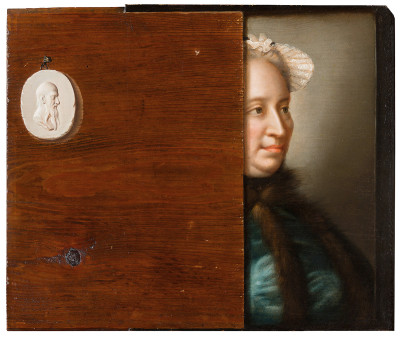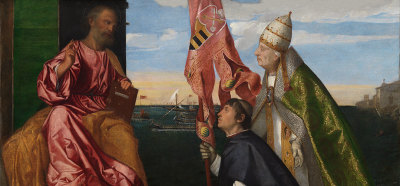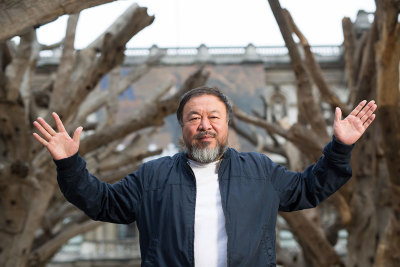Art history 101: what is trompe l’oeil?
Art history 101: what is trompe l’oeil?
By Mari Griffith
Published 30 November 2015
Liotard was a skilled portrait painter – but he also liked a joke, and was a key exponent of trompe l’oeil. Here’s a quick introduction to this strange phenomenon in art history.
-
Jean-Étienne Liotard enjoyed great renown as a portraitist. But in later life, he made a group of paintings with a more mischievous edge, showcasing his virtuoso skill at evoking different textures and creating convincing visual illusions. Made for his own delight rather than as commissions, these baffling works demonstrate Liotard’s technical mastery and his eccentric tendencies. This type of painting is called trompe l’oeil.
What does trompe l’oeil mean?
Trompe l’oeil is French for “to deceive the eye”, an art historical tradition in which the artist fools us into thinking we’re looking at the real thing. Whether it’s a painted fly that we’re tempted to brush away, or an illusionistic piece of paper with curling edges that entices us to pick it up, trompe l’oeil makes us question the boundary between the painted world and ours.
Who began this trickery?
The earliest account of trompe l’oeil comes from ancient Greece, where a contest took place between two prominent artists, Zeuxis and Parrhasius. The story goes that Zeuxis painted grapes with such skill that birds flew down to peck at them. Not wanting to be outdone, Parrhasius painted an illusionistic curtain that fooled even the discerning eye of his fellow-painter, who tried to draw it to one side. This famous anecdote was repeated in later art treatises, encouraging artists to emulate their classical predecessors.
Did it catch on?
Indeed. By the Renaissance, artists had a new tool at their disposal to deceive the viewer’s eye: perspective. In architecture in particular, trompe l’oeil moved onto an ever-grander scale with decorated ceilings that conjured up the illusion of infinite space – the ultimate test of a master’s skill. In some cases, buildings appear to continue upwards to great heights, while in others the heavens themselves seem to open up. The term di sotto in sù (“from below” in Italian) is used to sum up this soaring effect.
-

Giacomo Barozzi da Vignola, A trompe-l’oeil ceiling with columns, balconies and arches, seen from below.

Andrea Mantegna (1431–1506), Camera degli Sposi: Ceiling Oculus, Palazzo Ducale, Mantua, Italy, ca. 1474.
-
So it was mainly used for buildings?
Not quite. Trompe l’oeil can be at its most compelling in portraits, where it can make subject seem to emerge from the painting. In a remarkable example painted in the mid-16th century by an unknown Flemish artist, a smiling boy stands behind a casement window tapping the glass pane as if trying to call our attention and with his other hand reaching for the window latch as if to open it. His presence is eerily palpable on the walls of Hampton Court Palace, where the painting now hangs.
What else have artists fooled us with?
Trompe l’oeil reached new heights in the 17th century, particularly among Dutch artists, who achieved new levels of realism. One of these, Evert Collier, specialised in trompe l’oeil paintings, or “deceptions” as they were known, and produced many for the English market. His illusionistic letter racks are so convincing, they provocatively tempt us to reach out for the well-thumbed papers tucked behind the leather straps – until we look closer and realise we’ve been fooled.
-

Edward Collier, A Trompe l'Oeil of Newspapers, Letters and Writing Implements on a Wooden Board, c. 1699.

Nicolas de Largillière, Two Bunches of Grapes, 1677.

Flemish School, A Boy Looking through a Casement, c.1550-60.
-
What did Liotard do?
17th-century Dutch art was much admired by Jean-Etienne Liotard, and may have inspired his own trompe l’oeil paintings; he produced around ten. In one, two marble bas-reliefs hang above two drawings, casting shadows that make them look solidly three-dimensional. The wood beneath is skilfully evoked through paint, but in the second work, Liotard deepened the visual puzzle by incorporating real wood. Half the panel is left unpainted, apart from a small painted bas-relief, which makes it look like a cover revealing the portrait beneath. It’s a clever and sophisticated conceit that calls to mind the famous curtain painted by Parrhasius centuries earlier.
-

Jean-Etienne Liotard, Trompe-l'oeil with a Partial Portrait of Maria Theresa of Austria, 1762–63.

Jean-Etienne Liotard, Trompe l'oeil with Two Bas-reliefs and Two Drawings, 1771.
-
Are artists still tricking us today?
Yes; today’s most frequent employer’s of trompe l’oeil are perhaps street artists. Bringing the powers of illusionism to a broader audience, they often use trompe l’oeil to startle and stop passers-by in their tracks – whether it’s the illusion of a crater cutting into a city pavement or, in the case of Banksy, painted figures interacting with the fabric of our urban environment.
-
Liotard's trompe l'oeil
Curator MaryAnne Stevens introduces the artist’s mischievous works
-
Jean-Etienne Liotard is in The Sackler Wing at the RA from 24 October 2015 – 31 January 2016. Exhibition organised by the Royal Academy of Arts, London, and the National Galleries of Scotland.










